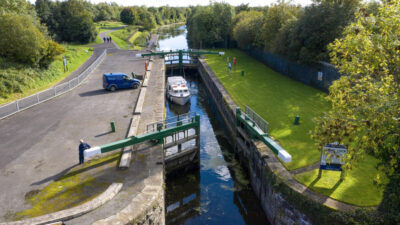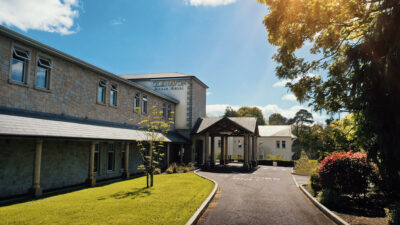Mid Ulster's Newest Tourism Offering
Friel's New Visitor Centre Honours the Legacy of Dr. Mooney and the Resilience of a Community.
The Great Famine remains one of the darkest periods in Irish history, affecting communities throughout the island. In Swatragh, a new visitor centre, Gorta, commemorates the famine years by telling the poignant story of Dr. Mooney—a local figure who went above and beyond to aid those affected. The Friel family home, now transformed into Gorta, is more than just a museum; it’s a tribute to the resilience and solidarity of the people of Swatragh, who came together to endure this crisis.
A Significant Find: The Famine Pot
One of the most striking features of Gorta is the presence of an original famine pot—an essential artifact that further connects the visitor experience to the reality of famine-era Ireland. These large iron pots, used in public soup kitchens, were essential in distributing food to those in desperate need. The discovery of the pot was serendipitous and added a tangible, historical centrepiece to Gorta, symbolizing both the aid efforts led by Dr. Mooney and the importance of community resources during the famine.
The pot, now a central exhibit, invites visitors to pause and reflect on the lives of those who once depended on it. It serves as a reminder of the community’s resilience and Dr. Mooney’s commitment to alleviating suffering, offering visitors a way to connect with history in a very personal, impactful way.
A Lifeline for Swatragh: The Story of Dr. Mooney
At the heart of Gorta’s narrative is Dr. Mooney, a compassionate local doctor who, during the famine, dedicated his life to saving others. Dr. Mooney was not only a healer but took it upon himself to establish a soup kitchen which became a vital lifeline for the people in Swatragh and surrounding areas, providing sustenance to those facing starvation and extreme hardship. Dr. Mooney’s story, meticulously researched and presented at Gorta, illustrates the selfless actions of individuals who went to great lengths to help their communities survive. The soup kitchen provided nourishment and hope, alleviating the suffering of many who had nowhere else to turn. This narrative of care and resilience highlights the importance of community solidarity in the face of immense challenges.
Extensive Research: Crafting a Powerful, Authentic Narrative
The creation of Gorta was a collaborative effort that brought together historians, researchers, and artists to ensure the story of Dr. Mooney and the Swatragh community was faithfully preserved. Historian Dr. Ciaran Reilly, an expert on the Irish Famine, played a key role in researching and curating the centre’s exhibits. By focusing on the local impact of the famine in Northern Ireland, Dr. Reilly’s work provided essential insights into the lives of ordinary people, ensuring that their stories were brought to life with authenticity and respect. Working closely with Marcon Heritage, a specialist firm in heritage projects, Dr. Reilly and the Gorta team transformed the Friel home into a space that balances historical integrity with modern interpretive elements.
Art and Memory: Sculptures by Kieran Tuohy
Adding depth to Gorta’s storytelling are sculptures by Irish artist Kieran Tuohy, which capture the emotional and human side of the famine’s legacy. Tuohy’s work includes sculptures representing the suffering and endurance of the people of Swatragh, giving form to emotions that are often difficult to express through words alone. His sculptures convey both sorrow and strength, embodying the resilience of those who survived and honoring the memory of those who did not.
Through expressive forms and carefully chosen materials, Tuohy’s art complements the factual narrative with a visceral reminder of the famine’s human toll. His work is both a tribute to Dr. Mooney’s compassion and a reminder of the enduring spirit of the community.
Interactive Exhibits and Immersive Storytelling
The exhibit invites visitors to engage with the history of the famine, utilizing interactive displays, soundscapes, and visuals to recreate the atmosphere of 19th-century Ireland. Marcon Heritage’s expertise in design allowed the team to create a multisensory experience, bringing visitors closer to the experiences of those who lived during this time. The exhibits include records that reflect the experiences of people who lived through the famine in Swatragh. Gorta offers a perspective on the famine that feels personal, connecting modern visitors with the people and communities who experienced this tragedy.
Through this immersive storytelling approach, Gorta invites visitors to understand the famine not just as a historical event but as a series of human stories marked by resilience and compassion. Each exhibit encourages quiet reflection, allowing visitors to absorb the weight of the history and the strength of the people who endured it.
A Space for Reflection and Remembrance
Gorta has been designed with great sensitivity, acknowledging the solemn nature of the history it presents. Visitors are encouraged to take their time, moving through the space at their own pace and connecting with the story of Dr. Mooney and his efforts to aid his community – Gorta allows visitors to walk through history and understand the weight of the past and the enduring strength of communities like Swatragh.
Gorta stands as a testament to the resilience and compassion that defined Swatragh during the Great Famine. Through the selflessness of Dr. Mooney, the generosity of the community, and the dedication of those involved in creating this visitor centre,
A New Addition to the Loughinsholin Tourism Cluster
As a proud member of the Loughinsholin Tourism Cluster, Gorta adds a profound cultural and historical dimension to the region’s tourism offerings and enriches the tourism landscape in Northern Ireland, providing visitors with a unique opportunity to engage with history in a meaningful and authentic way.
The addition reflects the cluster’s commitment to experience-driven, community-focused tourism that highlights the depth of Northern Ireland’s history. Through Gorta, visitors gain a deeper understanding of local resilience, endurance, and compassion, themes that resonate far beyond the historical specifics of the famine itself. Gorta offers a deeply moving experience, fostering connections between past and present, and ensuring that the history of Swatragh and the legacy of Dr. Mooney continue to inspire and educate for generations to come.
Learn more about Gorta
Discover NI Profile
Published: 5 November 2024




